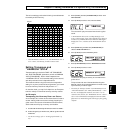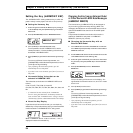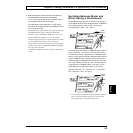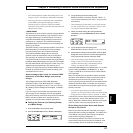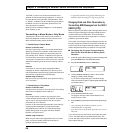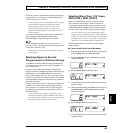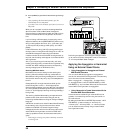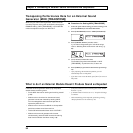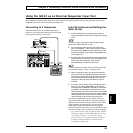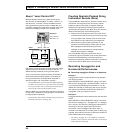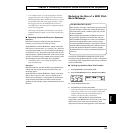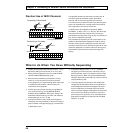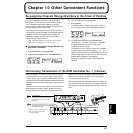
91
Chapter 9 Connecting to External Sound Generators and Sequencers
Chap.
9
The Relationship Between Envelope
Follow Function and MIDI Message
Patches that use the Envelope Follow function (p. 36)—in
other words, patches for which “Envelope1” or “Envelope2”
has been selected for the COMMON “PLAY FEEL” setting in
the Patch Edit mode—send information on string amplitude
(decay) during play to MIDI OUT on MIDI Control Change
No. 18 (general control 3).
This is mainly used during recording and playback of
performances on the GR-33 itself through a loop connection
with a MIDI sequencer (p. 94), and is for recording guitar-
string envelopes (decay information) along with the played
sounds and playing back the performed sounds without
change.
When using an external MIDI sound generator that can
assign tone changes and other effects to any desired Control
Change message that is received, you can also use No. 18
(sent as described above) to create changes in sounds.
Controlling External MIDI Devices
with the Pedal
The GR-33’s built-in pedal effects and some expansion pedal
effects can also be applied to an external sound generator.
❍
Pedal Effect 1 (WAH)
Messages about pressing and releasing the pedal are sent on
Control Change No. 19. When “Modulation” has been
selected as the “WAH TYPE” setting (p. 43), Control Change
No. 1 is used, not No. 19.
❍
Pedal Effect 2 (P-GLIDE)
MIDI Pitch Bend messages are used to create an effect similar
to the effect for the built-in sound generator.
❍
Pedal Effect 3 (HOLD)
This is achieved by causing issuance of MIDI Note Off
messages to be paused during a hold. (A Control Change No.
64 used with keyboards is not sent. For control of the internal
sound generator, however, pedal action is sent on Control
Change No. 82 (general control 7).)
* When transmitting in Poly mode (p. 88), string-specific
processing is impossible when the same pitch is played on
different strings, so the hold effect can not be perfectly
conveyed.
❍
Pedal Effect 4 (CTRL)
Arpeggiator and Harmonist can be turned on and off in the
same was as for the built-in sound generator.
About Expression Pedal Effects
When an expression pedal is used to apply some sort of
effect, the pedal’s action is output from MIDI OUT. This
output is usually made with Control Change No. 4 (foot
type), but other numbers can be used by changing the “EXP
PEDAL” setting (p. 47) as follows.
“Volume”
: Control Change No. 7
“Pitch”: MIDI Pitch Bend messages
“Modulation”: Control Change No. 1
“Pan (Normal)”: Control Change No. 10
“Cho Send Level”: Control Change No. 93
“Rev Send Level”: Control Change No. 91
“Tempo&Pitch”: MIDI Pitch Bend messages
and Control Change No. 4
In addition to these, when a value from “CC1 to 31” or from
“CC64 to 95” has been selected for the “EXP PEDAL” setting
(p. 47), the Control Change message of the corresponding
number follows the operation of the expression pedal and is
output only from MIDI OUT. This makes it possible to use
the pedal to control only the external MIDI sound generator.
* When the GR-33 receives Control Change No. 4, the synth
sound of the GR-33’s internal sound generator changes
according to the function assigned to the expression pedal at
that time. However, when a function using a specific Control
Change message such as the foregoing No. 7, No. 1, or No. 91
has been assigned, No. 4 is ignored.



